Related Research Articles

Leishmaniasis is a disease caused by parasites of the Leishmania type. It is spread by the bite of certain types of sandflies, and occurs most frequently in the tropics and sub-tropics of Africa, Asia, the Americas, and southern Europe. The disease can present in three main ways: cutaneous, mucocutaneous, or visceral. The cutaneous form presents with skin ulcers, while the mucocutaneous form presents with ulcers of the skin, mouth, and nose. The visceral form starts with skin ulcers and later presents with fever, low count of red blood cells, and enlarged spleen and liver.
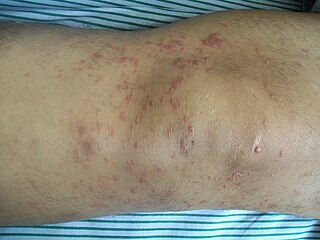
Mycosis fungoides, also known as Alibert-Bazin syndrome or granuloma fungoides, is the most common form of cutaneous T-cell lymphoma. It generally affects the skin, but may progress internally over time. Symptoms include rash, tumors, skin lesions, and itchy skin.

Tuberculosis verrucosa cutis is a rash of small, red papular nodules in the skin that may appear 2–4 weeks after inoculation by Mycobacterium tuberculosis in a previously infected and immunocompetent individual.
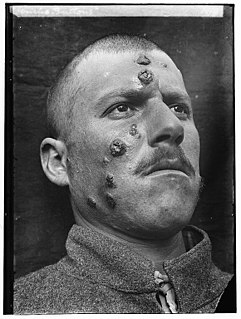
Cutaneous leishmaniasis is the most common form of leishmaniasis affecting humans. It is a skin infection caused by a single-celled parasite that is transmitted by the bite of a phlebotomine sandfly. There are about twenty species of Leishmania that may cause cutaneous leishmaniasis.

The iliohypogastric nerve is a nerve that originates from the lumbar plexus that supplies sensation to skin over the lateral gluteal and hypogastric regions and motor to the internal oblique and transverse abdominal muscles.

The lateral cutaneous nerve of the thigh is a cutaneous nerve that innervates the skin on the lateral part of the thigh.

Blue nevus is a type of melanocytic nevus. The blue colour is caused by the pigment being deeper in the skin than in ordinary nevi. In principle they are harmless but they can sometimes be mimicked by malignant lesions, i.e. some melanomas can look like a blue nevus.
Lymphomatoid papulosis (LyP) is a rare skin disorder. The overall prevalence rate of lymphomatoid papulosis is estimated at 1.2 to 1.9 cases per 1,000,000 population. This rare condition has only been studied in depth since 1968.
Subacute cutaneous lupus erythematosus is a clinically distinct subset of cases of lupus erythematosus that is most often present in white women aged 15 to 40, consisting of skin lesions that are scaly and evolve as poly-cyclic annular lesions or plaques similar to those of plaque psoriasis.
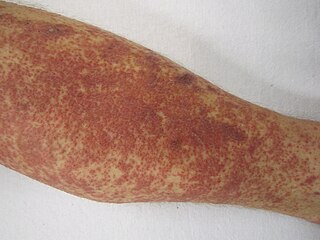
Cutaneous small-vessel vasculitis (CSVV), also known as hypersensitivity vasculitis, cutaneous leukocytoclastic vasculitis, hypersensitivity angiitis, cutaneous leukocytoclastic angiitis, cutaneous necrotizing vasculitis and cutaneous necrotizing venulitis, is inflammation of small blood vessels, characterized by palpable purpura. It is the most common vasculitis seen in clinical practice.
Plummer's nail is a clinical sign in which there is onycholysis, or separation of the nail from the nail bed, particularly affecting the ring and little fingers. It occurs in patients with thyrotoxicosis. About 5% of hyperthyroid patients display abnormal nail changes. Plummer's nail is also associated with psoriasis, traumatic injury, and allergic contact dermatitis.
Paraneoplastic acrokeratosis, or Bazex syndrome is a cutaneous condition characterized by psoriasiform changes of hands, feet, ears, and nose, with involvement of the nails and periungual tissues being characteristic and indistinguishable from psoriatic nails. The condition is associated with carcinomas of the upper aerodigestive tract.
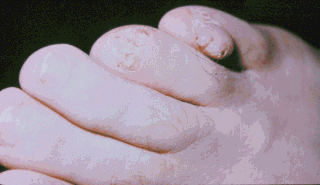
Koenen's tumor is a cutaneous condition that results in fifty percent of tuberous sclerosis cases.It can be subungual too.
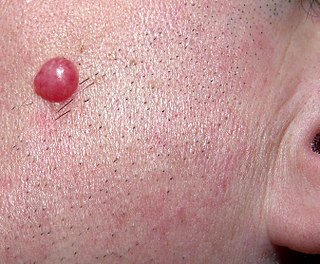
Cutaneous lymphoid hyperplasia refers to a groups of benign cutaneous disorders characterized by collections of lymphocytes, macrophages, and dendritic cells in the skin. Conditions included in this groups are:
Infantile acne is a cutaneous condition that usually presents between 3 to 6 months of age.

A Myxoid cyst is a cutaneous condition often characterized by nail plate depression and grooves.
Hair follicle nevus is a cutaneous condition that presents as a small papule from which fine hairs protrude evenly from the surface.

Kraurosis vulvae is a cutaneous condition characterized by atrophy and shrinkage of the skin of the vagina and vulva often accompanied by a chronic inflammatory reaction in the deeper tissues.
Laryngo-onycho-cutaneous syndrome is a rare epithelial disorder inherited in an autosomal recessive fashion. It is characterized by abnormalities in the larynx, nails ("onycho-"), and skin ("cutaneous"). The disorder is only found in Punjabi Muslims and only a few cases have been reported.
Sarcoidosis, an inflammatory disease, involves the skin in about 25% of patients. The most common lesions are erythema nodosum, plaques, maculopapular eruptions, subcutaneous nodules, and lupus pernio. Treatment is not required, since the lesions usually resolve spontaneously in two to four weeks. Although it may be disfiguring, cutaneous sarcoidosis rarely causes major problems.
References
- ↑ Rapini, Ronald P.; Bolognia, Jean L.; Jorizzo, Joseph L. (2007). Dermatology: 2-Volume Set. St. Louis: Mosby. ISBN 978-1-4160-2999-1.
| | This dermatology article is a stub. You can help Wikipedia by expanding it. |